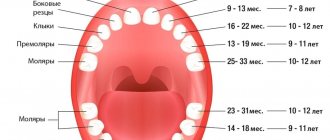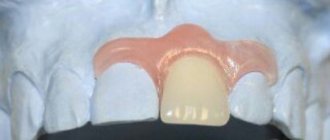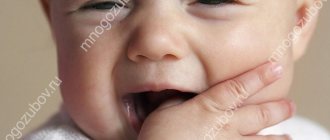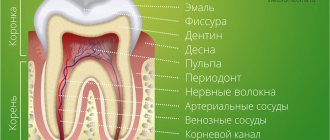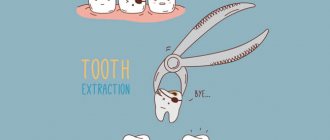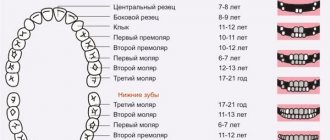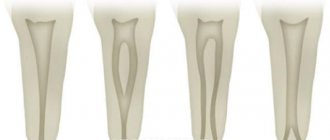Milk and molar teeth in children
Many people believe that there are no differences between permanent and temporary teeth, but this is not true. So, how to distinguish a baby tooth from a molar? At a minimum, their number differs (milk - 20, permanent, as a rule, 32). Temporary teeth have a light shade, while permanent teeth are naturally more yellow. Indigenous ones are also significantly larger in size than dairy ones - visually it is quite easy to distinguish them. Here are the most common questions asked by Internet users on this topic.
- Do children have molars?
Of course, there are, and at a certain point they begin to actively erupt. - How many molars do children have?
From 28 to 32 (the maximum set appears after all eights appear). - Which molars appear first in a child?
Typically, the lower central incisor erupts first. - At what age do children start to get their molars?
Usually, dentition renewal begins after 6–7 years, but there are no strict limits. - Do children lose molars?
By themselves - no, as a result of injuries and illnesses - yes. - What are the risks of removing a molar tooth in children?
As corny as it may sound, his loss. And yes, a new one will not grow. Everything is like adults. - What to do if a child has yellow molars?
Permanent teeth have a more yellowish tint than temporary teeth. Plaque on a child’s molars is normal, but hygiene should never be neglected. - What to do if a child has black molars?
When teething, baby teeth may have a black color (the so-called Priestley plaque, or pigment bacteria). However, this does not happen with molars. If they are black, go to the dentist immediately. - What to do if a child does not have molar buds?
This happens, but very rarely. Fortunately, with modern implantation and prosthetics technologies, the problem can be solved. - Is it normal for a child to have crooked molars?
Contact an orthodontist immediately: correcting a bite in childhood is much easier and faster than in adults. - Which teeth do children replace with molars?
All twenty, plus new molars appearing.
The main differences between baby teeth and permanent teeth
Unlike 28 permanent teeth, the primary dentition requires the presence of 20 units. At the same time, they have a number of characteristic features.
- Smaller in size compared to permanent teeth.
- White with a slightly blue tint (permanent units have a slightly yellowish tint).
- Less developed and slightly short roots compared to permanent teeth.
- The enamel of primary teeth is poorly formed - thinner.
- Milk units can be erased (permanent ones can too, but this is considered a pathology).
As the child grows, baby teeth fall out on their own - this is the norm. The permanent dentition units should not fall out on their own.
Molars in children: symptoms of eruption
- Fever. When teething in children, body temperature may rise, usually not higher than 38 degrees.
- Itching and pain at the site where the molar appears. Various gels and ointments, as well as gum massage, will help relieve children from unpleasant sensations.
- Increased salivation and runny nose.
Important!
The growth of molars in children, especially at the initial stage, leads to weakened immunity. Take vitamins and do not forget about preventive visits to the dentist.
Formation of permanent bite
The development of molars in children begins in the prenatal period and lasts until 18–20 years, when their structure fully corresponds to “adult” parameters. That is why their condition, as well as the exact timing of eruption, depend on many factors. This:
- genetic predisposition, which is associated with metabolic characteristics;
- insufficient consumption of mineral elements in food, and we are talking about the nutrition of not only the child, but also the woman during pregnancy;
- fluoride deficiency in water and food;
- compliance with hygiene rules;
- some infectious diseases suffered by the mother (during gestation);
- insufficient functional activity of the salivary glands, since saliva contains certain substances that additionally provide mineralization of enamel, etc.
How does teething occur?
With the exception of rare cases of congenital or acquired pathologies, the appearance of molars coincides with the time of loss of milk teeth. Usually, part of the permanent tooth is already visible in this place; sometimes its growth is delayed for a short time, which is also one of the normal options.
Contrary to popular belief, temporary teeth have roots, and they differ in shape and structure from permanent ones: they can be curved and “sit” quite deeply in the gums. But as the child grows up and the rudiments of the molars grow, the “temporary” roots gradually dissolve and on an x-ray they look “eaten away”, shortened.
In this case, the pulp, where the nerve endings and blood vessels are concentrated, is replaced by granular tissue, which also participates in the resorption of the “milky” root system. And if depulpation (nerve removal) was previously performed due to injury or advanced caries, this process occurs faster.
When does a child's molars come out?
Most parents are interested in the question: at what age do children’s molars begin to erupt? The first buds form in the fifth month of pregnancy. The exact timing of their appearance has not been determined and depends on the individual characteristics of the organism. Nevertheless, an approximate scheme for the eruption of molars in children exists. If the appearance of a permanent tooth is delayed for more than six months from the extreme threshold (especially after the loss of a baby tooth), consult a specialist. The doctor will take control of the process and be able to identify complications.
What does a dental formula look like?
To make it more convenient to describe teeth and their number, special formulas are usually used. Each tooth has its own number, which is used to decipher its location.
When describing a milk bite, Roman numerals are used:
- incisors – I, II;
- canine – III;
- molars – IV, V.
If we talk about the formula for adult teeth, here the teeth are counted starting from the center:
- incisors – 1.2;
- fang – 3;
- molars (small) – 4.5;
- molars (large) – 6,7,8.
8 is a wisdom tooth; not every person has it.
Pattern of growth of molars in children
In most cases, the permanent tooth appears 3 to 5 months after the temporary tooth falls out. The order of eruption of molars is in many ways similar to the appearance of milk teeth. The first molars in children are the central lower incisors. The upper permanent teeth develop later than the lower ones, if we consider them in pairs.
| Age | Eruption of molars in children |
2 years | There have been references in history where a child was born with one or more molars. Cases when molars erupted in a 2-3 year old child also occur, but are extremely rare (less than 1%). |
5 years | When a child is 5 years old, molars very rarely come out (less than 10% of the total). If a baby tooth falls out on its own at such an early age, then there is every reason to believe that a permanent one will soon appear in its place. |
6 years | The roots of baby teeth (especially the upper and lower incisors) begin to dissolve and the teeth fall out. Usually, it is at the age of 6 that a child’s first molar begins to erupt. |
7 years | At this age, the first lower molars in children (at least one of them) have already erupted and the incisors of the upper jaw are next in line. |
9 years | At the age of 9, a child’s second molar should definitely have time to appear. Some children acquire lateral incisors and even a premolar on one of the jaws. |
10 years | At the age of ten, children’s back molars begin to actively erupt (premolars, and a little later – molars and canines). |
13 years | At 12–13 years of age, children usually develop a full bite of permanent teeth. The last teeth to emerge are usually the upper canines and second molars. This does not apply to wisdom teeth, which appear in adulthood (after 17–18 years) or may not erupt at all. |
Molars, their types
Immediately after the fangs there are 2 small molars - premolars. The structure of these teeth has its own characteristics: premolars generally have one root, consisting of two canals. Also, on the closure surface, they have only two tubercles. The crown shape is spherical. They are mainly involved in tearing and cutting food.
The second type of root teeth is called large - these are molars. They are located last in the dentition. Their total number is 12 (6 each on top and bottom). Three molars on the left and three on the right on each jaw. The third molar is the wisdom tooth. It appears later than the other molars.
Large molars perform the task of grinding food.
Therefore, they have a more complex structure. The shape of the molar crown resembles a cube. On the surface, the teeth have a wide closure area and three or four cusps. Large molars, which are located on the upper jaw, have basically four root canals, and lower molars have three canals.
Complications during teething
- Delay in the appearance of permanent teeth.
This may be due to genetic characteristics, immune system problems and a number of other diseases. - Uneven teeth and other malocclusions.
- Hyperdentia.
The child’s molar tooth (or teeth) grows in the second row. Hyperdentia, or supernumerary of teeth, is a fairly rare phenomenon, but requires the intervention of a dentist to eliminate the risk of malocclusion in a child.
Features of the period
PHOTO: The lateral incisors of the upper jaw do not have enough space in the dentition and, therefore, they erupted in the anterior direction - crowding of the teeth of the upper jaw formed.
The permanent incisors are wider and higher than the primary incisors, therefore, as they appear, the interdental spaces decrease (in the primary bite, there are normally large gaps between the incisors and canines), and the jaws grow. If in the primary occlusion there were no spaces between the incisors and canines, then the eruption of the permanent incisors will be accompanied by the formation of crowding of teeth in the anterior part of the lower and upper jaws.
As a result of active sports, injury to the front teeth of the upper jaw often occurs. Most often, complete dislocation of the incisors occurs when, as a result of a strong blow, the tooth falls out of its socket.
To prevent dislocation and fracture of permanent incisors, it is enough to wear a special sports individual dental mouth guard (boxing or hockey) made by a children's orthodontist during sports (hockey, karate).
Common problems with molars in children
| Problems with molars | How to fix? |
| Molar tooth is loose | A common occurrence with injuries and bruises. To avoid tooth loss, an urgent visit to the dentist and the application of a special splint are necessary, especially if the child’s molar sways when touched. |
| Broken molar tooth | Severe chips may require orthopedic treatment. If a child's front molar has chipped, aesthetic restoration with veneers or crowns may be required. |
| Molar caries | When the first molars erupt, it is important to prevent the occurrence of caries. If this happens, then it is necessary to stop the disease in its infancy, otherwise it will affect the deeper layers of the tooth. |
| A child's molar has fallen out | The most unpleasant thing that can happen. If a child knocks out a molar along with the root, then there is a chance to save it. To do this, you need to place the knocked out tooth back into the oral cavity, saline solution or into a glass of milk and urgently rush to the dentist (you need to do it within 30 - 40 minutes after the injury). If a child’s molar tooth has been removed, then there is only one way out - installing a prosthesis. |
Anatomy of permanent teeth
Each molar consists of certain parts:
- crown. This is the part of the tooth that protrudes from the top;
- the root, it goes deep into the alveoli. At the same time, it is attached thanks to special connective tissue bundles. There can be different numbers of roots (1-5 pieces). This moment affects the number of nerves and channels;
- neck. This part is located between the root and the crown.
Tooth tissues are distinguished by their heterogeneity. The enamel is on top and is known for its durability. Once the tooth has erupted, it is covered with a transparent thin layer. This is the cuticle, which eventually changes to the pellicle. The latter is a film that is created from what saliva produces.
Beneath the enamel is dentin, the tissue of the tooth. Dentin is similar to bone when you study how it is built. However, it is more durable because there is a high level of mineralization. In the area where the root is located, the dental tissue is covered with cement. The latter is rich in mineral compounds and is also associated with periodontium. Collagen fibers are used for this.
As for the part of the tooth that is inside, this is the crown and root canal. They are filled with pulp. This is loose connective tissue; it contains nerve endings and blood vessels.
Care instructions
Molars in children require even more careful care than in adults. Frail enamel is much more susceptible to the effects of carious bacteria and the external environment, and the love of sweets and carbonated drinks does not add strength to it. When children develop a permanent bite, parents need to take special control of oral hygiene and diet (at least until the age of 14–15, when the teenager himself begins to realize the importance of dental health). In general, there are no difficulties here: in order to keep children's teeth strong and healthy, you need to follow several basic points.
- Daily hygiene.
Brush your teeth at least twice a day, use dental floss and special rinses. - Proper diet.
Limit your intake of sweets and carbohydrates. - Preventative visits to the dentist at least once every six months.
If necessary, fluoridation and sealing of molars in children (so-called fissure sealing). - Do not forget to wear a protective mouth guard during active games and sports.
Useful tips on how to preserve teeth from childhood
The most important requirements are regular hygiene and preventive examinations at the dentist.
It is very important for parents to develop the right habit in their child from childhood in order to maintain it for the rest of his life and protect his teeth from many dental problems. How to save teeth from childhood
| First visit to the dentist | The first visit to the dentist with your baby is necessary at the age of one year in order to make sure that the first teeth are growing and growing correctly. It is better to carry out medical examinations every six months, and after three years - every 3-4 months. This is explained by the fact that the tissues of baby teeth are quite soft and carious processes spread extremely quickly. |
| First visit to the orthodontist | You should visit an orthodontist for the first time at the age of 3-4 years. At this time, you can make the first attempts to correct the position of the jaws and elements of the dentition. Naturally, if there are serious congenital malocclusion pathologies, it is necessary to consult a doctor as soon as possible |
| When to start brushing your child's teeth | Hygienic procedures must be carried out from the moment the very first tooth appears. Many parents believe that cleaning can be neglected while the baby is on breast milk or until his firstborns are fully grown. But this is not so: the first teeth need especially careful hygiene - the growth and formation of a permanent bite largely depends on them. At the first stage, you can use a soft silicone cap, after 1-1.5 years - a baby brush with soft bristles, as well as a special paste selected according to age |
| Should a child get dentures? | Baby teeth not only need to be treated, but also replaced with children's dentures if they were removed too early. This will allow you to maintain the position of the others in the row and thereby form the correct permanent bite. |
| How often should you use a toothbrush? | You need to clean with a brush and paste 2 times a day: before breakfast and before bed, after all meals. In between, you need to use dental floss, irrigator and mouth rinse. |
| How often should you visit the dentist? | Adults need to visit a doctor every six months. Firstly, to examine the condition of the entire oral cavity, identifying problems at an early stage. Secondly, for comprehensive hygiene, which will better clean the enamel and gums from plaque |
The completion of tooth root formation occurs at approximately this age:
| Teeth | Upper jaw, age | Lower jaw, age |
| Central incisors | 9-13 | 7-11 |
| Lateral incisors | 9-12 | 8-11 |
| Fangs | 9-12 | 9-12 |
| First premolars | 11-13 | 11-13 |
| Second premolars | 11-13 | 11-13 |
| First molars | 9-12 | 9-12 |
| Second molars | 14-15 | 14-15 |
Since the eruption of third molars does not occur at a specific time, it is impossible to establish a clear age at which their roots are formed.
X-ray results confirm the completion of the process of tooth root formation. The key signs are the absence of an opening at the apex, as well as a pronounced periodontal contour.
Thus, completion of dental growth, including full maturation, usually occurs only between the ages of 15 and 18 years. It is at this time that the maxillofacial apparatus already has the same dimensions as in adults.
